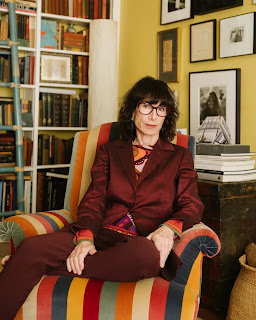This blog is an interview with Judith Thurman, author of Isak Dinesen: The Life of a Storyteller, winner of the National Book Award for Autobiography/Biography; and Secrets of the Flesh: A Life of Colette. A staff writer at The New Yorker, she lives in New York City. Thurman discusses her most recent book, A Left-Handed Woman.
 |
| Judith Thurman |
Zack Rogow: Many of the essays in A Left-Handed Woman are profiles of remarkable women, from nineteenth-century feminist Margaret Fuller, to Amelia Earhart, to Cleopatra, to modernist ceramics designer Eva Zeisel. Is there a shared feature about their lives or work that stimulated you to write about all of them?
Judith Thurman: They all share a passionate drive to distinguish and to express themselves. They all refused or at least resisted beholdenness to the various conventions and strictures that their societies imposed on women. They also possessed an unusual self-confidence in their gifts. The four subjects you mention were, in particular, unusually fearless characters. That fearlessness took different forms: moral, sexual, political, physical, creative.
Q. Your notion of feminism seems wide-ranging to me, encompassing women as varied as Simone de Beauvoir, and Helen Gurley Brown of Cosmopolitan magazine. Would you be willing to say a few words about your own idea of feminism—what it includes and does not include?
JT: The Second Wave feminism of my generation, at least in America, had a puritanical streak that I always found limiting, not to say, provincial. Taking pleasure in fashion and décor, for example, or caring about one’s appearance, was considered a bit shameful, if not reactionary. On the other hand, girls were, and in many places, still are, oppressed by unattainable and demeaning standards of beauty. (Standards designed, for the most part, to attract the interest and cater to the desires of men.) So yes, the life and career of Helen Gurley Brown send a mixed message. But then so do the life and career of Simone de Beauvoir! Let’s get rid of feminist purity tests. A feminist is anyone of any gender who supports the dignity and empowerment of girls and women.
Q. In the profiles you write, you find surprising depth in topics that on the surface don’t seem to lend themselves to profundity. One of my favorite essays in the book, for example, is about a renowned personal shopper at the department store Bergdorf Goodman. How do you find substance in situations that many people might see as trivial?
JT: That question relates to your previous one. When I started writing about fashion for The New Yorker, I got a certain amount of flak from intellectual friends who told me I was wasting my time and talents on a frivolous subject. But every person on the planet who can get out of bed in the morning, then gets dressed. Clothing is a universal language, a highly coded one, that deserves the interest of a serious cultural and social critic.
Q. There is often a turn in your profiles where you sketch the subject’s childhood or backstory. What sorts of details or incidents do you look for in a personal history to provide context or gravitas for their later achievements?
JT: I don’t look for the details ahead of time. I just listen. And the details usually emerge, or even flag themselves by the intensity with which they’re recounted. As I write in the introduction to A Left-Handed Woman, my essential though tacit question for every subject is, “How did you become who you are?” You can never ask that outright, of course, but it’s the leitmotif that I listen for in a subject’s narrative of her life.
Q. How do you decide how much of Judith Thurman to include in a certain profile? When do you feel it’s right to make your own experience part of the profile of another person? To what extent do you withhold your own connection to your topic?
JT: It’s not always or mostly a conscious decision. I don’t like writing about myself, or not explicitly. But there are no perfect human prisms: you are always filtering a subject’s story through your own experience (though you have to be careful about doing that, so you aren’t projecting). But sometimes, a personal anecdote is the launching pad for my first paragraph—a connection with the subject that eases me into the stream of the story. And sometimes a subject’s trajectory helps me to arrive at an understanding of some deep, hitherto unarticulated feeling of my own. I mention a few such moments in the introduction: moments of clarity about myself that are all the more precious for taking me by surprise.
Zack’s memoir about his father, the writer Lee Rogow: Hugging My Father’s Ghost
Zack’s most recent book of poems, Irreverent Litanies
Other posts of interest:
Getting the Most from Your Writing Workshop
How Not to Become a Literary Dropout
Putting Together a Book Manuscript
Does the Muse Have a Cell Phone?
Poetic Forms: Introduction, the Sonnet, the Sestina, the Ghazal, the Tanka, the Villanelle
